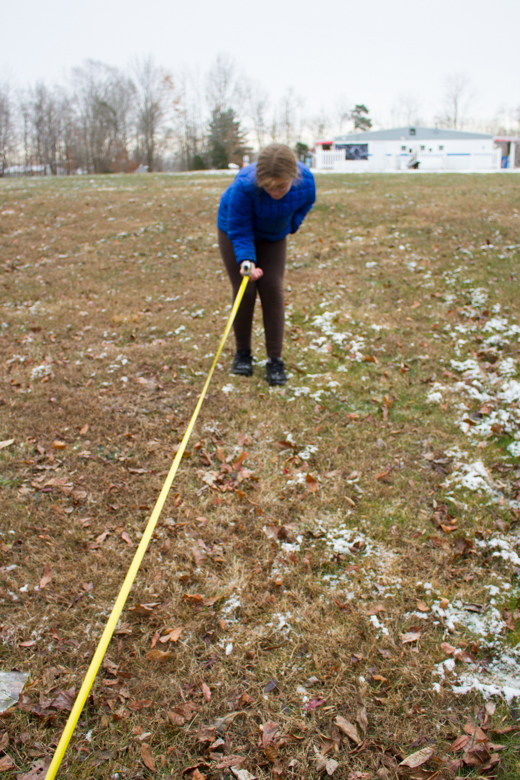Take two similar right triangles:
 |
| via Skwirk |
If the ratio of triangles ABC:DEF was 1:10, then you could multiply side AC times 10 to get side DF. You could multiply side BC times 10 to get side EF. Here's more information about how that works.
To measure something really tall, then, you're going to use that 1:10 ratio. Here's what you do!
1. Go find something really tall. Hmmm..... I wonder what is near us that is also really tall?
Found something!
2. Measure out 30 feet from the drive-in screen:
A couple of places for human error here are the fact that the ground has a slope and that the kids are measuring, so don't expect perfect accuracy.
3. Take two yardsticks. One goes straight on the ground, pointing toward the drive-in screen. Set the other up so that it makes an angle with the prone yardstick, then put your eye as close to the vertex as you can and sight up to the top of the drive-in screen.
It was about 20 degrees, max, on this afternoon, by the way. This kid is a baller.
4. Get a partner to wrap the angle with duct tape so you can move it. Our yardsticks also came with holes in the ends, so a better method would be to buy a bolt, washer, and wingnut so that you could simply tighten the wingnut and hold the angle that way.
In a pinch, though, duct tape is fine:
5. You are now going to measure out your similar right triangle that's 1/10 of this size. So whereas you were 30 feet from the drive-in screen, you now need to be three feet from the drive-in screen:
6. Place the vertex of your angle at the three-foot location, get back down on the ground so that you're once again eye-level with the vertex, and sight back along that top yardstick again:
7. Verbally direct your partner to the point that your sight-line leads you to. Warning: your partner might be kind of acting like an asshole:
8. Measure the height from the ground to that point (side BC), and multiply by ten. Your answer is side EF, or the height of the drive-in screen!
When we did this, we got a measurement of 60 feet for the drive-in screen's height. I have no idea if this number is at all correct, particularly since I can pinpoint several instances of possible human error in our process. The next time that I happen to see the family who owns the drive-in, however, I plan to ask!
If you're doing this project with kids, you'll probably want to limit the large something that you measure to less than 90 feet, since 1/10 of that would be 9 feet, and even middle graders are going to have a hard time reaching up that high with a tape measure. I also wouldn't use this for measurements of heights that you could easily measure by hand, since smaller numbers will just make the inaccuracy of the human error stick out more--even a miscalculation of five feet isn't such a big deal with a drive-in screen, but for a nine-foot deck, that same miscalculation would be pretty egregious.
And yes. This is one of the many reasons why I love math!








No comments:
Post a Comment